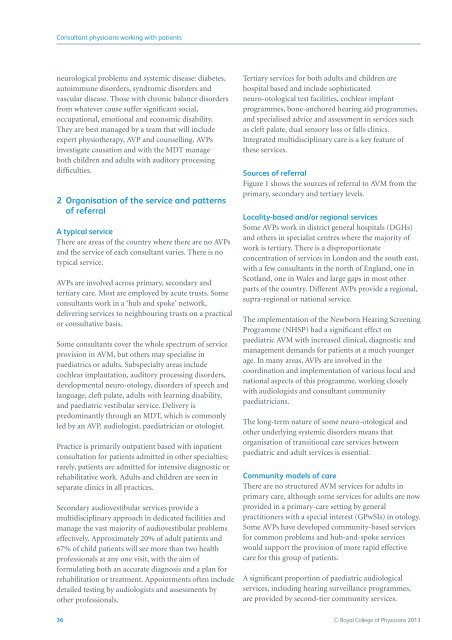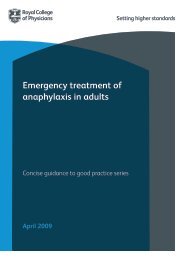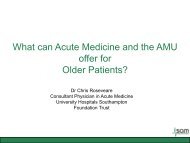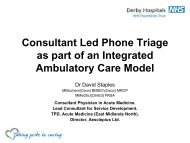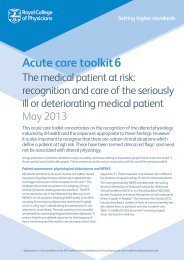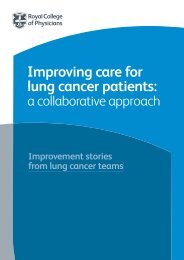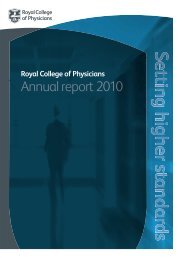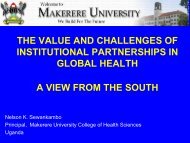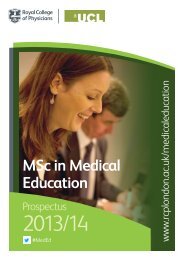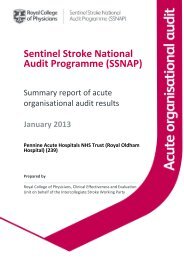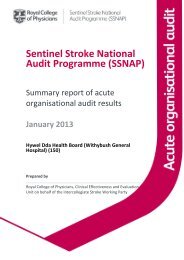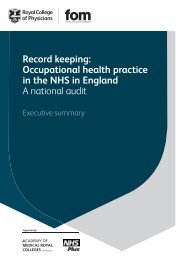Consultant physicians working with patients - Royal College of ...
Consultant physicians working with patients - Royal College of ...
Consultant physicians working with patients - Royal College of ...
Create successful ePaper yourself
Turn your PDF publications into a flip-book with our unique Google optimized e-Paper software.
<strong>Consultant</strong> <strong>physicians</strong> <strong>working</strong> <strong>with</strong> <strong>patients</strong>neurological problems and systemic disease: diabetes,autoimmune disorders, syndromic disorders andvascular disease. Those <strong>with</strong> chronic balance disordersfrom whatever cause suffer significant social,occupational, emotional and economic disability.They are best managed by a team that will includeexpert physiotherapy, AVP and counselling. AVPsinvestigate causation and <strong>with</strong> the MDT manageboth children and adults <strong>with</strong> auditory processingdifficulties.2 Organisation <strong>of</strong> the service and patterns<strong>of</strong> referralA typical serviceThere are areas <strong>of</strong> the country where there are no AVPsand the service <strong>of</strong> each consultant varies. There is notypical service.AVPs are involved across primary, secondary andtertiary care. Most are employed by acute trusts. Someconsultants work in a ‘hub and spoke’ network,delivering services to neighbouring trusts on a practicalor consultative basis.Some consultants cover the whole spectrum <strong>of</strong> serviceprovision in AVM, but others may specialise inpaediatrics or adults. Subspecialty areas includecochlear implantation, auditory processing disorders,developmental neuro-otology, disorders <strong>of</strong> speech andlanguage, cleft palate, adults <strong>with</strong> learning disability,and paediatric vestibular service. Delivery ispredominantly through an MDT, which is commonlyled by an AVP, audiologist, paediatrician or otologist.Practice is primarily outpatient based <strong>with</strong> inpatientconsultation for <strong>patients</strong> admitted in other specialties;rarely, <strong>patients</strong> are admitted for intensive diagnostic orrehabilitative work. Adults and children are seen inseparate clinics in all practices.Secondary audiovestibular services provide amultidisciplinary approach in dedicated facilities andmanage the vast majority <strong>of</strong> audiovestibular problemseffectively. Approximately 20% <strong>of</strong> adult <strong>patients</strong> and67% <strong>of</strong> child <strong>patients</strong> will see more than two healthpr<strong>of</strong>essionals at any one visit, <strong>with</strong> the aim <strong>of</strong>formulating both an accurate diagnosis and a plan forrehabilitation or treatment. Appointments <strong>of</strong>ten includedetailed testing by audiologists and assessments byother pr<strong>of</strong>essionals.Tertiary services for both adults and children arehospital based and include sophisticatedneuro-otological test facilities, cochlear implantprogrammes, bone-anchored hearing aid programmes,and specialised advice and assessment in services suchas cleft palate, dual sensory loss or falls clinics.Integrated multidisciplinary care is a key feature <strong>of</strong>these services.Sources <strong>of</strong> referralFigure 1 shows the sources <strong>of</strong> referral to AVM from theprimary, secondary and tertiary levels.Locality-based and/or regional servicesSome AVPs work in district general hospitals (DGHs)and others in specialist centres where the majority <strong>of</strong>work is tertiary. There is a disproportionateconcentration <strong>of</strong> services in London and the south east,<strong>with</strong> a few consultants in the north <strong>of</strong> England, one inScotland, one in Wales and large gaps in most otherparts <strong>of</strong> the country. Different AVPs provide a regional,supra-regional or national service.The implementation <strong>of</strong> the Newborn Hearing ScreeningProgramme (NHSP) had a significant effect onpaediatric AVM <strong>with</strong> increased clinical, diagnostic andmanagement demands for <strong>patients</strong> at a much youngerage. In many areas, AVPs are involved in thecoordination and implementation <strong>of</strong> various local andnational aspects <strong>of</strong> this programme, <strong>working</strong> closely<strong>with</strong> audiologists and consultant communitypaediatricians.The long-term nature <strong>of</strong> some neuro-otological andother underlying systemic disorders means thatorganisation <strong>of</strong> transitional care services betweenpaediatric and adult services is essential.Community models <strong>of</strong> careThere are no structured AVM services for adults inprimary care, although some services for adults are nowprovided in a primary-care setting by generalpractitioners <strong>with</strong> a special interest (GPwSIs) in otology.Some AVPs have developed community-based servicesfor common problems and hub-and-spoke serviceswould support the provision <strong>of</strong> more rapid effectivecare for this group <strong>of</strong> <strong>patients</strong>.A significant proportion <strong>of</strong> paediatric audiologicalservices, including hearing surveillance programmes,are provided by second-tier community services.36 C○ <strong>Royal</strong> <strong>College</strong> <strong>of</strong> Physicians 2013


